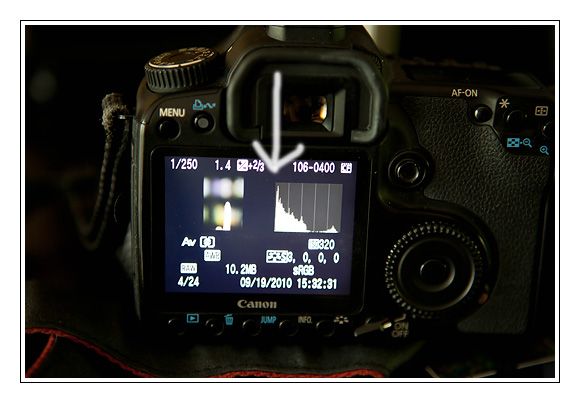
And the same thing with losing the details in the dark spots - the underexposure is such that you lose details..... example...

So -how do I get a proper exposure? See this little ticker-thingy right here on the screen of my camera?

That shows you whether or not you are getting proper exposure. The way you get this little ticker guy to move is by adjusting your aperture and your shutter speed until they find a common ground (or have your ticker in the middle). Let's say you have selected an ap of say 4.0 with a shutter speed of 200, and arrived at correct exposure. Then you can also change this by adjusting each of these two things a "stop" up or down, and still have proper exposure. For example, you decide to narrow your aperture, to get some nice bokeh, then you move your ap down 2-3 stops, while adjusting your shutter speed accordingly 2-3 stops. Your goal is to always have that at the mid-point. In this example, it is exactly in the middle - this shows proper exposure. Now - even though that is the goal - there are times, many times, that you will want to have it slightly to the right or slightly to the left to compensate for light and dark areas in an image. I think on Nikon cameras, this looks more like a digital gas gauge in your car - with more or less bars lighting up, instead of just a moving ticker like on the Canons. I mentioned in the prior post that your camera has an internal light meter. It is reading all the lights and darks of the image you are about to snap. Now is when YOUR brain gets to make choices in proper exposure. With your camera in manual, YOU can decide if you want to slightly underexpose or slightly overexpose (technically called exposure compensation) your image. Take for instance the picture above where I took a picture of my camera. My light meter was "reading" everything it was seeing and telling me where I fell on that exposure line. My brain has to know that my camera is seeing a lot of black in the image, therefore it will try to tell me that I need to brighten up some. (That little ticker exposure thing that I see is going to be far over to the left telling me that I am about underexposure my picture). When in reality I know that it is just seeing a lot of dark areas, and my brain needs to overrule the cameras brain. Make sense? Let's try again using whites. You know how when you take pictures out in the snow - the snow in your image usually turns out really gray instead of white? (So, okay, I guess you Floridians don't know about that, but it's a common thing in most other places). The reason is because your internal light meter is reading all that white and is trying to compensate for that. Your camera is always trying to balance out the lights and the darks and find a "neutral gray". So, when I am shooting in snow, I know that my exposure reading is going to be far over to the right and I am going to use MY brain to compensate for that. Clear as mud? That's what I thought. It's like trying to explain how the insides of a computer work - well, because, thats kind of exactly what it is. A little mini computer. So - to sum it up - you want your little ticker-thingy-exposure-meter-thingy (what IS that called anyway?) to always be near the middle.
Taking that a step further - the best way that I know if I am getting proper exposure is by reading the internal HISTOGRAM on my camera. If you are ready to take your skills to the next level it is very important that you are able to read your histogram. This is a graph that measures all the light and dark information in an image that you just took. For the most part - you want your histogram to look like a little hill (or hills) right in the middle of the graph.

If the "hill" is smooshed over to the left side of the graph, then you have underexposed the
image. (Oh look - I even underexposed the image of my underexposed image - HA!)

If the hill is smooshed over to the right side, then you have overexposed the image.

(pardon the history book under the camera) :)
Sometimes, just previewing your image on your camera can make you think you have proper exposure, until you check the histogram, then you can see if you are overexposing or underexposing. There will be times that your histogram will have lots of little hills in it - this is okay, it's just taking in all the information of the lights and darks (and even colors), but the main rule of thumb is to not let anything be smacked up against either the right or left wall of the histogram. So, check your manual and find out how to pull up the histogram for each image.
Let's chat a little bit about FOCUS. I mentioned in my previous post that most photographers leave their lenses on automatic focus. This part is when you can most definitely let that computer inside your camera work for you. I think the exception to this is if you are into macro phography (kind of like using a magnifying glass or microscope type of photography), then you might want to use your lens in manual focus. Most photographers I know always let the lens do this part. The part you WANT to do yourself is to choose your focal point. Again - dig through your manual to find out how to easily change your focal points. Let's pretend I have a little newborn baby laying in front of me and his precious little piggy toes are just so sweet that I want to snap a picture of just his toes... like this!!

So, I choose a low aperture so that the rest of the image will be kind of blurry so that we can focus just on his toes. This is when I want to select a focal point that lies just on his toes. If I had chosen a focal point that was further over to the right - then we might have focused on his face and then his toes would have been out of focus. If you want the whole baby in focus, this is when you would put your aperture at a much higher number, like 6, 8 or above (again, depth of field comes into play here). In this picture my aperture was at 2.8. The cameras that I use have only nine focal points - but I know there are lots of other cameras out there with LOTS of focal points (ahem... ERIN!!). So, I choose one of my nine focal points.

You can see them here on the screen on top of my camera - but all of this information I can also see as I am looking through my lens. I change my focal points on the fly with every image that I take while never even taking my eye off my camera. This is a goal that you want to be able to get to. You should know your camera inside and out so that you can change these focal points without even having to stop and think about it. If the spot on your image falls at a place where you don't have a focal point, you simply place one of your focal points on the spot where you want it, push your shutter button half-way down to lock in the focus, and then while holding the button down, reposition your camera to the way you want the picture taken, and then finish pushing down the shutter button. This can be kind of tricky and I rarely use that method - but it works when you have to use that option.
Here is a good way to make sure you are nailing your focus - after you select your focal point, lets say on the eyes, like in this picture....

I make double and sometimes triple sure that I have locked in the focus right on the eyes by pressing my shutter button half way down several times. By pressing it half way down, it will focus and make a little beeping sound (if you have your camera set to do so). This is how I know I have focus, I then lift my finger and do it again, and sometimes even a third time (a little bit of my OCD showing itself here) - I have found that by doing this is can get a super sharp focus exactly where I want it!! Just a little tip...
Well, that is enough info to digest for today. Next up - all about LIGHT!! How to read it, how to use it, and how to get that sparkle in the eyes!!
















1 comments:
Maybe pictures only get blown highlights when Im in them :)
Maddie
Post a Comment